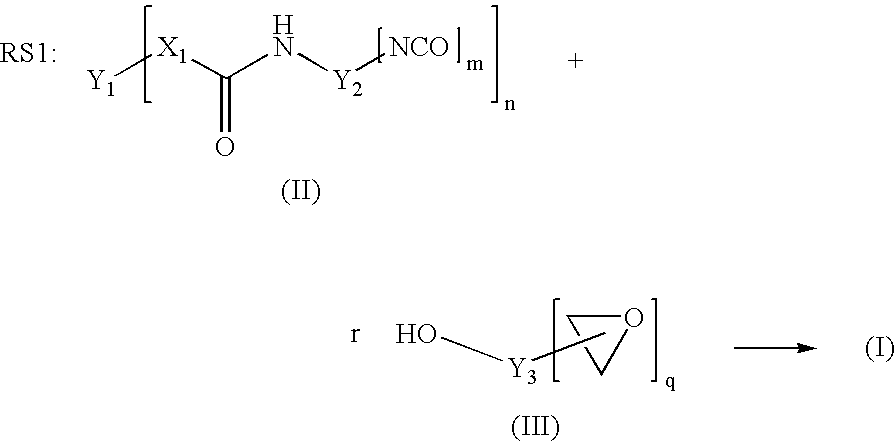Thermally hardenable epoxy resin composition having an improved impact resistance at low temperatures
a technology of epoxy resin and composition, which is applied in the direction of epoxy resin adhesives, adhesive types, adhesives, etc., can solve the problems of insufficient strength at low temperatures (10° c.) and high brittleness of epoxy adhesives, and achieve good impact modifiers
- Summary
- Abstract
- Description
- Claims
- Application Information
AI Technical Summary
Benefits of technology
Problems solved by technology
Method used
Image
Examples
example 1
Of a polymer B: B-01
[0098] 200 g of polyTHF 2000 (OH number 57.5 mg / g KOH) were dried for 30 minutes in vacuo at 100° C. 47.5 g of IPDI and 0.04 g of dibutyltin dilaurate were then added. The reaction was carried out in vacuo at 90° C. to a constant NCO content of 3.6% after 2.5 h (theoretical NCO content: 3.7%). 123.7 g of the trimethylolpropane glycidyl ether described above were then added as monohydroxyl-containing epoxide of the formula (III). Stirring was continued at 90° C. in vacuo until the NCO content had decreased below 0.1% after a further 3 h. After the end of the reaction, 82.5 g of DGEBA were added (1 / 3 of the mass of the unblocked prepolymer having terminal NCO). A clear product having epoxide content (“final EP content”) of 3.15 eq / kg was obtained.
examples 2-5
Of a polymer B: B-02 to B-05
[0099] The exemplary polymers B summarized in table 2 and terminated with epoxide groups, referred to as B-02 to B-05, were synthesized on the basis of different polyols or polyol mixtures according to the table below, in the same manner as described for example B-01. The amount of trimethylolpropane glycidyl ether required for terminating the terminal NCO groups was exactly adapted to the NCO content reached after the first synthesis stage. The amount of DGEBA added for dilution was calculated in the case of all prepolymers as ⅓ of the mass of the prepolymer prepared in the first synthesis stage and having terminal NCO.
example 6
Of a Chain-Lengthened Polymer B: B-06
[0100] Example 6 B-06 is an example of a polymer B in which the Y1-based polymer is a chain-extended diol.
[0101] 200 g of polyTHF 1000 (OH number 114 mg / g KOH) were dried for 30 minutes in vacuo at 100° C. 73.5 g of IPDI and 0.04 g of dibutyltin dilaurate were then added. This corresponds to a molar [NCO] / [OH] ratio of 1.6 / 1 and, as already described, leads to a chain extension of the polymer forming. The reaction was carried out in vacuo at 90° C. to a constant NCO content of 4.9% after 2.5 h (theoretical NCO content: 5.1%). 186.1 g of the trimethylolpropane glycidyl ether described above were added as monohydroxyl-containing epoxide of the formula (III). Stirring was continued at 90° C. in vacuo until the NCO content had decreased below 0.1% after a further 3.5 h. After the end of the reaction, 91.2 g of DGEBA were added (⅓ of the mass of the unblocked prepolymer having terminal NCO). Thus, a clear product having an epoxide content (“final EP...
PUM
| Property | Measurement | Unit |
|---|---|---|
| Temperature | aaaaa | aaaaa |
| Temperature | aaaaa | aaaaa |
| Temperature | aaaaa | aaaaa |
Abstract
Description
Claims
Application Information
 Login to View More
Login to View More - R&D
- Intellectual Property
- Life Sciences
- Materials
- Tech Scout
- Unparalleled Data Quality
- Higher Quality Content
- 60% Fewer Hallucinations
Browse by: Latest US Patents, China's latest patents, Technical Efficacy Thesaurus, Application Domain, Technology Topic, Popular Technical Reports.
© 2025 PatSnap. All rights reserved.Legal|Privacy policy|Modern Slavery Act Transparency Statement|Sitemap|About US| Contact US: help@patsnap.com



